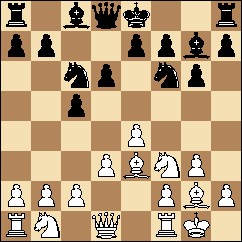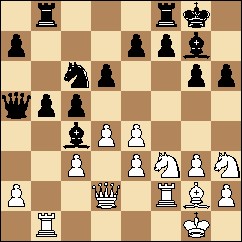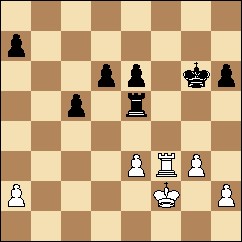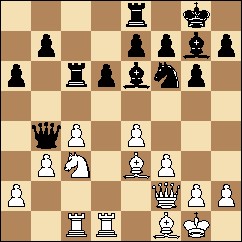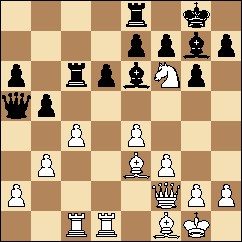Rapidplay HV Neth B Bd 2 (Chartist), 2007
Round 1 [Geoff Peake]
1.c4 e5 2.Nc3
Nf6 3.Nf3 Nc6
4.g3 Bc5 5.Nxe5 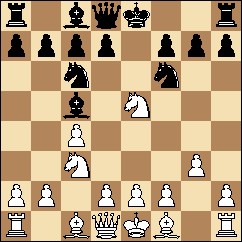 First analysed by Botvinnik, this move is given an exclamation mark by Taimanov in his Slav,English, Reti book. It is a tricky line.Black's best is Bxf2+, as played by Keres against Botvinnik. 5...Nxe5 This is inferior to Bxf2+ and has only scored 31% for Black. | ||
|
[5...Bxf2+ 6.Kxf2
Nxe5 7.e4 c5 ! 8.d3
d6 9.h3 h5
10.Be2 Nh7 11.Kg2
h4 12.g4 Ng5
13.Be3 Bd7 14.Qd2 ! Ne6
15.b4 b6 16.Rab1
Bc6 17.Rhf1 Bb7
18.Kg1 Nc6 19.Nd5
Ncd4 20.Bd1 f6
21.Kh2 Bc6 22.a4
a5 ? 23.bxa5
bxa5 24.Qf2 Ra7
25.g5 ! | ||
| (25...Nxg5 26.Bxg5 fxg5 27.Bh5+ !) | ||
|
(25...fxg5 26.Bxd4
Rf8 27.Bh5+ Kd7
28.Qf7+ ! Rxf7
29.Rxf7+ Kc8 30.Rxa7 | ||
| 26.g6 ! f5 | ||
|
(26...Be8 ! 27.Qg2 ! f5 (27...Ng5
28.Nf4 | ||
| 27.Rb8 !] | ||
|
1-0, Botvinnik Mikhail M 2630 - Keres Paul 2615 , Moscow 1966 Memorial A.Alekhine 6.d4 Nxc4 I am not aware of anyone playing this move. Black regains his pawn, but Black loses his dark squared Bishop, and his Knight is poorly placed. | ||
|
[6...Bb6 7.dxe5
Ng4 8.e3 Nxe5
9.f4 Nc6 10.Bg2
| ||
7.dxc5 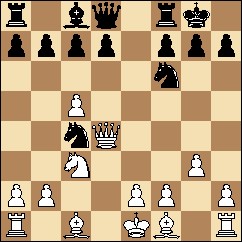 A strong move that centralises the Queen, attacks the Knight. White also has options of Bg5 emphasising his dark square power. 8...d5 9.Bg2 White threatens the d5 pawn, and rushes to castle, as he then has the strong e4! move. 9...c6 10. 11.e4 ! Nxe4 ? a blunder, but remember this is a rapidplay game. | ||
| [11...Be6 had to be played, but White is better.] | ||
12.Nxe4 Re8
13.Bxh6 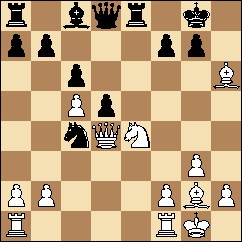 ! crashes open the Black King position. 13...gxh6 | ||
| [13...f6 is best. 14.Bf4 with a winning advantage.] | ||
|
14.Nf6+ Kf8 Obviously
forced, otherwise White get a discovered check. 15.Nxe8 Kxe8 | ||
| [15...Qxe8 16.Rae1 Be6 17.f4 is hopeless for Black.] | ||
| 16.Rfe1+ | ||
| [16.Rae1+ Be6 17.f4 is also killing.] | ||
|
16...Be6 17.b3 not
just pushing the Knight out of play, but gaining the d6 square for a Queen check later. 17...Na5 18.Bh3 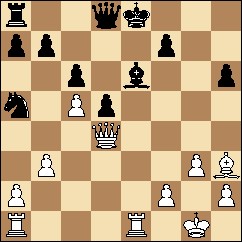 White has a winning attack. 18...Kd7 Best. | ||
| [18...Qd7 19.Bxe6 fxe6 20.Qf6 is murderous] | ||
|
[18...Qe7 leads to a tortuous end. 19.Qh8+ Qf8 20.Qh7 Qe7 21.Qg8+ Qf8 22.Rxe6+ fxe6 23.Qxe6+ Qe7 24.Qg8+ Qf8 25.Re1+ Kd8 26.Qxf8+ Kc7 27.Qd6#] | ||
| [18...Ke7 19.Qg7 threat R or B xe6, Black doesn't have a move.] | ||
|
19.Qf4 This sneaky move prevents the
King from running away, but White had mate in 10 !! | ||
|
[19.Rxe6 ! is mate in another 9 moves
! 19...fxe6 20.Bxe6+ Kxe6 | ||
| (20...Ke8 21.Qh8+ Ke7 22.Qg7+ Kxe6 23.Re1+ Kf5 24.Re5#) | ||
|
21.Qg7 etc Qh4 to
prolong the agony | ||
| (21...Qd7 22.Re1+ Kf5 23.Re5#) | ||
| (21...Nc4 22.Re1+ Kf5 23.bxc4 Qc7 (23...Qf6 24.g4+) 24.g4+ Kf4 25.Qf6+ Kxg4 26.f3+ Kh5 27.Qf5+ Kh4 28.Qg4#) | ||
| 22.gxh4 Kf5 23.Re1 Rg8 24.Qxg8 Nc4 25.Qf7+ Kg4 26.f3+ Kxh4 27.Qf4+ Kh5 28.Qg4#] | ||
| 19...Bxh3 ? | ||
|
[19...Kc8 is now answered by 20.Rxe6 ! fxe6 21.Bxe6+] | ||
|
20.Qxf7+ Kc8
21.Re8 Black resigns 1-0 | ||
Dave Tooley - G.M. Peake
Rapidplay 07 (Chartist), 2007
Round 2 [Geoff Peake]
| 1.d4 Nf6 | ||
[1...e6 2.c4
f5 3.Nf3 Nf6
4.g3 d5 5.Bg2
c6 6.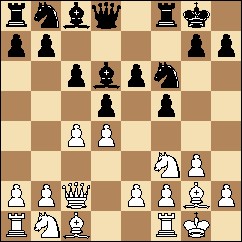 Compare this position in the Dutch Stonewall with the (reversed) position in the game.] | ||
|
2.Nf3 c5
3.e3 g6 4.c3
Qc7 In some lines White can play dxc5
and hang on to the pawn. 5.Bd3 Bg7 6. 7.Ne5 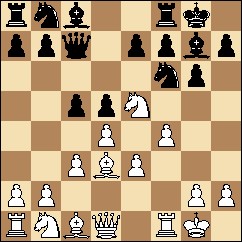 Compare this position with the Dutch Stonewall position mentioned above. 8...Ne8 The standard plan, Black will regroup the Knight to d6 and control e5 by playing f6 . 9.Nd2 Nc6 | ||
|
[9...f6 is possible immediately, but 10.Nxg6 hxg6 11.Bxg6 f5 12.Qh5 Nf6 13.Qh4 looked unclear and dangerous.] | ||
|
10.Nxc6 Qxc6
11.Qe1 Bf5 As
always, trading off White's King Bishop is favourable to Black in the Stonewall. White is shot on the
light squares 12.Bxf5 gxf5 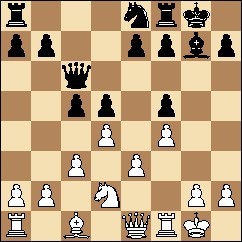 The doubled pawn is not important, Black gains a stranglehold on e4, which will be a superb Knight outpost, and an open g file. 13.Qh4 c4 I am already preparing for an ending where the Q-side breakthrough will be achieved by the march of the b pawn to b4. Taking the e7 pawn is too dangerous for White. 14.Nf3 | ||
|
[14.Qxe7 Nf6 threat
Re8 15.Nf3 Rfe8 16.Qb4 Bf8 etc. with excellent play] | ||
|
14...Qf6 Black aims to exchange Queens
to nullify any White kingside play, then he has much the better ending. 15.Bd2 Qxh4 16.Nxh4 Nd6 17.Nf3 Ne4 18.Be1 attempting to activate the Bishop with Bh4 18...h6 ? preventing Ng5 but a better move is Bf6 !, which also prevents Bh4. This move also allows Black to quickly utilise the g file. 19.Nh4 White's strategy has been to build a Stonewall and play moves quickly, to build a safe position and gain time on the clock. 19...e6 20.Nf3 White is achieving little in position, but he has accumulated a good time advantage with quick play. 20...Kh7 Here Bf6 was still a good idea. 21.Bh4 Rfe8 to prevent the Bishop's entry via e7 22.h3 White's play finally has some direction - he intends g4. However he fails in this, and g2,g3 squares are therefore much weakened. 22...Bf6 I finally realise that Bf6 is the best way to make progress, even though I am swapping off White's bad Bishop. 23.Bxf6 Nxf6 g4 is prevented and Black is ready to double Rooks on the g file. 24.Kh2 Rg8 25.Rg1 Rg7 26.g3 Rag8 27.Rg2 Ne4 28.Rag1 h5 controlling g4. Now White must beware Black pushing the pawn to h4 in some lines. 29.Nd2 Nd6 30.Nf3 f6 taking away e5 from the White Knight. Now White is confined to the first two ranks. Black has a good position, but progress is not easy. 31.h4 Now g4, g3 and e4, e3 are all weak 31...Nf7 32.Re2 to defend e3 against the Ng4 check move. 32...Nh6 33.Ree1 Ng4+ 34.Kh3 | ||
| [34.Kg2 may have been better.] | ||
34...Nf2+ 35.Kh2
Nd3 36.Re2 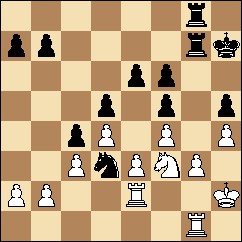 Black has made excellent progress, and now is ready to put his master plan into operation ! 36...b5 37.Nd2 A blunder ? or is this a trap ? 37...Nxb2 38.Nb1 | ||
|
[38.Ne4 suggested by Roger Tuddenham may
is better but ... 38...fxe4 Now Black gains f5 entry square for his King 39.Rxb2 Rb8 40.Rgb1 a6 41.a4 Kg6 42.axb5 Rxb5 43.Rxb5 axb5 44.Rxb5 Ra7 45.Rb2 Ra1 is a winning position for Black] | ||
| 38...Nd3 39.Na3 Rb8 40.Rb1 Rgb7 41.Nc2 a5 | ||
| [41...b4 immediately is very playable.] | ||
| 42.a3 b4 43.cxb4 axb4 44.axb4 Nxb4 45.Na3 Ra7 | ||
| [45...Nd3 is simpler, but I thought I saw a winning pin.] | ||
|
46.Nc2 Ra2 Unfortunately
I now realise that White's pin of my Knight negates my pin. 47.Kg1 Nc6 48.Rxb8 Nxb8 49.Kf1 Nc6 50.Ke1 Kg6 51.Kd1 Kf7 52.Kc1 Ke7 | ||
| [52...Na7 53.Kb1 Nb5 is a clever computer solution that I did not see.] | ||
| 53.Kb1 Ra8 | ||
|
[53...Nb4 ! I did see but did not realise
the strength of 54...c3! Now the time situation is becoming serious . This would be easy in a long play
game. 54.Kc1 c3 55.Kd1 | ||
| (55.Kb1 Rb2+ 56.Kc1 Nd3+ 57.Kd1 Rb1#) | ||
| 55...Nd3 wins] | ||
|
54.Na1 Rg8
55.Rb2 Desperately seeking counterplay
with his Rook. | ||
| [55.Rg2 White thought was too passive, as Black walks his King over to the Q-side .] | ||
|
55...Rxg3 56.Rb7+
Kd6 57.Nc2
Rh3 I realised that White's 2 move mate
threat of Na3 to b5 mate was an illusion. 58.Rf7 | ||
|
[58.Na3 is answered by 58...Nxd4 ! 59.Nxc4+ dxc4 60.exd4 Rb3+] | ||
58...Rxh4 59.Rxf6
Ke7 60.Rh6
Nd8 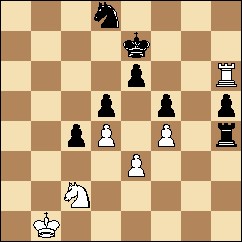 ! sneakily trapping the Rook 61.Nb4 | ||
| [61.Rh7+ Nf7 62.Rg7 Rg4 wins] | ||
|
61...Nf7 62.Rh7 ?
a blunder, but 62.Rg6 is answered by Rg4 ! Now White loses his Rook 62...Kf8 0-1 | ||
M.A. Fox - G.M.Peake
HV v Dewbury Rapidplay Bd 2 (White Hart), 2007
Round 3
Dave Gray - G.M.Peake
HV v David Browns Rapidplay Bd 2 (White Hart), 2007
Round 4
| 1.c4 Nf6 2.Nc3 d5 3.cxd5 Nxd5 4.e4 | ||
| [4.d4 g6 would be Grunfield] | ||
| [4.g3 is the most common 59% White] | ||
|
4...Nb4 !? A surprising reply - 60%
Black 5.d4 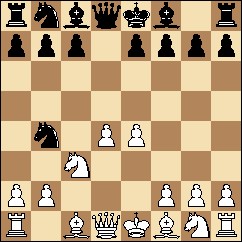 ? This has a shock refutation. | ||
| [5.d3 c5 6.a3 N4c6 has scored poorly for White.] | ||
| 5...Qxd4 ! 6.Qxd4 | ||
| [6.Qe2 ! is the best reply] | ||
|
6...Nc2+ 7.Kd1
Nxd4 8.Be3 Now
White does have a development lead for the pawn.He is attacking Black's Knight and has threats involving
Nd5 or b5. | ||
| [8.Nd5 is met by 8...Ne6 and c6] | ||
|
8...e5 !? Offering to return the
pawn seems best. 9.Bc4 | ||
|
[9.Bxd4 Going after the pawn seems poor. 9...exd4 10.Nb5 Na6 11.Nxd4 Bg4+ 12.Kc2 | ||
|
(12.f3 | ||
|
12...Nb4+ 13.Kb3
| ||
|
9...c6 I take time out for a defensive
move. This cuts out any Nd5 or Nb5 attacks 10.Nf3 Unwisely allowing the Bishop pin. Nge2 is better. 10...Bg4 11.Bxd4 Finally going after the d4 pawn. Be2 looks too defensive. 11...exd4 12.Ne2 Now Bxf3, followed by defending the d4 pawn appears logical, but as I look into the position I realise that Black can sacrifice the d4 pawn for the attack. 12...Nd7 ! Black sacks the d4 pawn, but now develops rapidly with threats. 13.Nfxd4 It's better with this Knight to allow a f3 pawn move. 13...Ne5 threatens the Bishop. 14.Bb3 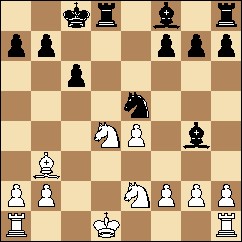 With both Knights pinned White is threatened with catastrophe. 15.Ke1 This is a crucial point. It is obvious that White is lost, but what is the quickest way to victory? The clock was ticking and I did not have time to "solve" the position. I finished up playing... | ||
|
[15.f3 instead then... 15...Nxf3 ! is a crusher 16.gxf3 Bxf3 threatens Rxd4ch as well as the Rook. I was now dreaming about the following line.. 17.Kc2 Bxe4+ 18.Kc3 c5 19.Nb5 a6 20.Na3 Rd3+ 21.Kc4 b5+ when White moved the King instead.] | ||
| [15.Kc2 c5 is nasty] | ||
| [15.Kc1 c5] | ||
| 15...c5 !? | ||
|
[15...Nd3+ is possibly strongest though
the main line is not dramatically different from the line that I played. 16.Kf1 Bc5 17.f3 Bxd4 18.Nxd4 Rxd4 19.fxg4 | ||
| (19.Rd1 Be6 20.Bc2 Rhd8) | ||
|
19...Re8 | ||
| 16.Nb5 c4 17.Bc2 Bb4+ 18.Kf1 | ||
|
[18.Nbc3 was forced, but after... 18...Nd3+ 19.Bxd3 cxd3 20.f3 the only move here, trust me, 20...dxe2 21.fxg4 Bxc3+ 22.bxc3 Rhe8 with a strong advantage.] | ||
|
18...Bxe2+ 19.Kxe2
Rd2+ It's hopeless for White. 0-1 | ||
Mike Denison - G.M.Peake
Rapidplay HV v Chartist (West Bretton Institute), 2007
Round 5
G.M.Peake - R.A. Broadbent
Rapidplay HV v Brighouse (West Bretton Institute), 2007
Round 6
1.c4 Nc6
2.Nc3 e5
3.Nf3 Nf6
4.g3 Be7
5.Bg2 d6
6.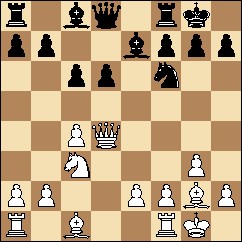 This position is77% White. 10.Bf4 | ||
|
[10.b3 is a good alternative. 10...Be6 11.Bb2 Qb6 12.Qd2 Rfd8 13.e4 Qa5 14.Rad1 Qh5 15.Ne2 Ng4 16.h3 Ne5 17.g4 Bxg4 18.hxg4 Nxg4 19.Qf4 Bg5 20.Qg3 Bh4 21.Qh3 Ne5 22.Ng3 Qg4 23.Qxg4 Nxg4 24.Nf5 Bg5 25.Nxg7 d5 26.exd5 Rd6 27.dxc6 Rg6 28.cxb7 Rb8 29.Nf5 1-0, Rosell Kaj (DEN) 2325 - Oe Oluf, Randers (Denmark) 1973] | ||
| 10...Qb6 ! 11.Qd2 | ||
|
[11.Rad1 I seriously considered as... 11...Qxb2 ? 12.Nd5 ! wins] | ||
|
11...Be6 12.Na4 Here
I start to go wrong. - I was attracted by the line Qc7 13. c5! 12...Qd8 | ||
|
[12...Qa6 ! looks good. 13.b3 d5] | ||
| [12...Qc7 13.c5] | ||
|
13.Qc2 vacating d1 for a Rook, and
defending c4. 13...Nh5 14.Be3 f5 15.Rad1 Qe8 16.b3 Nf6 | ||
| [16...f4 17.Bd4 | ||
| (17.Qe4 Bf5) | ||
| 17...Bf5 18.Qd2 =] | ||
|
17.Nc3 getting a stranglehold on
d5. 17...Ng4 18.Bf4 Ne5 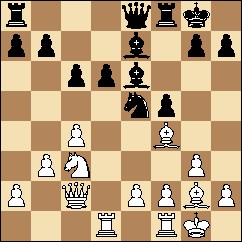 ?! This is where I miss my chance. The Rapidplay disease strikes. I should, of course play c5 ! now. 19.Qd2 preventing g5 and preparing Bg5. | ||
|
[19.c5 | ||
| 19...Rd8 20.Bg5 | ||
| [20.c5 Nf7 | ||
|
(20...dxc5 21.Qe3 | ||
|
21.cxd6 Bxd6
22.Bxd6 Rxd6
23.Qe3 a6 | ||
| 20...Bxg5 21.Qxg5 Qf7 | ||
|
[21...Rf6 22.Qe3 | ||
22.Rd4 Qf6
23.Qxf6 Rxf6
24.Rfd1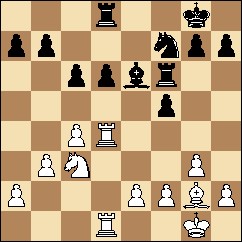 Now I'm happy as White obviously has a better position. But how to continue ? No time to think. 25.e4 | ||
| [25.f4 ! blocking the f4 pawn first is the right way to continue, with e4! to follow.] | ||
| 25...f4 26.gxf4 | ||
| [26.c5 fxg3 | ||
|
(26...f3 27.Bf1
Bc8 28.e5
Nxe5 29.Ne4 | ||
|
27.hxg3 Bg4
28.R1d2 b6
29.cxd6 Rfxd6
30.Rxd6 Rxd6
31.Rxd6 Nxd6
32.e5 Nb5
33.Nxb5 cxb5
34.f4 | ||
|
26...Rxf4 27.Ne2
Rf6 28.f4 ?
Oops - Blunders away a pawn. | ||
|
[28.h3 | ||
|
28...Bg4 29.R4d2
Bxe2 30.Rxe2
Rxf4 31.e5
dxe5 32.Rxd8+
Nxd8 33.Rxe5
Kf7 1/2-1/2 | ||
Peter Shaw - G.M.Peake
Rapidplay HV v Netherton A (West Bretton Institute), 2007
Round 3
|
1.d4 Nf6
2.c4 c5
3.d5 e6
4.Nc3 exd5
5.cxd5 d6
6.Nf3 g6
7.g3 Bg7
8.Bg2 11.Nc4 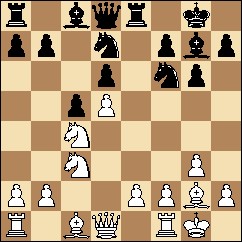 ? Here a4 is essential, as will soon become obvious | ||
| [11.a4 a6 is the main line but it's 54% Black in 740 games on my database.] | ||
|
11...Nb6 ! This position has only
scored 19% for White ! 12.Qb3 | ||
| [12.Nxb6 Qxb6 79% Black] | ||
| [12.Ne3 Ng4 is only 17% White] | ||
|
12...Nxc4 13.Qxc4
a6 ! with a threat that cannot be countered. 14.a4 b5 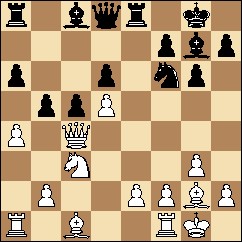 ! the point of this line. White cannot take the pawn as his Queen and Rook become en prise simultaneously. 15.Qd3 | ||
| [15.Qh4 b4 16.Ne4 Bf5 17.Nxf6+ Qxf6 18.Qxf6 Bxf6 19.Re1 Bc2 20.Bf4 Rad8 21.e4 Bxb2 22.Ra2 Bc3 23.Re3 Bb3 24.Rae2 Bxa4 25.Ra2 Bb5 26.Bf1 b3 27.Rxc3 bxa2 28.Ra3 Rxe4 29.Bxb5 Re1+ 30.Kg2 a1=Q 31.Rxa1 Rxa1 32.Bg5 axb5 33.Bxd8 b4 34.Bc7 b3 35.Bxd6 b2 0-1, Ambrosio G Felix (MEX) 2051 - Gonzalez Roberto (MEX) 2210, Mexico 1999] | ||
| 15...b4 16.Ne4 | ||
| [16.Nd1 a5 17.Ne3 Ba6 18.Qc2 Nd7 19.Nc4 | ||
| (19.Rb1 c4 20.h4 Rc8 21.Kh2 f5 22.Bh3 Qf6 23.Re1 c3 24.bxc3 Qxc3 25.Qd1 Qd4 26.Bd2 Nc5 27.Bg2 Re7 28.Kg1 Rce8 29.Nc2 Qc4 30.Be3 Nxa4 31.Nxb4 Nc3 32.Qd3 axb4 33.Qxc4 Bxc4 34.Rxb4 Bxd5 35.Rb6 Bxg2 36.Kxg2 Nd5 0-1, Walbaum Klaus (GER) 2025 - Voss Hubertus (GER) 2199, NRW (Germany) 1996) | ||
| 19...Ne5 20.Nxe5 Bxe5 21.Re1 Qf6 22.Rb1 c4 23.Be3 Rab8 24.Red1 b3 25.Qd2 c3 26.bxc3 Bxc3 27.Bd4 Bxd4 28.Qxd4 Qxd4 29.Rxd4 Bxe2 30.Bf1 Bxf1 31.Kxf1 Rec8 32.Rb2 Rc2 33.Rb1 b2 34.Rdd1 Rb4 35.Kg2 Rxa4 0-1, Preiss Veronikia (GER) 2229 - Send Sebastian (GER) 1900, Dortmund (Germany) 1999] | ||
|
16...Nxe4 | ||
| [17.Bxe4 Qc7 | ||
|
(17...Qe7 18.Bf3
Bf5 | ||
| 18.Qc4 a5 19.Bf3 Ba6 20.Qc2 c4 21.Bf4 Rab8 22.Rfd1 b3 23.Qd2 c3 24.bxc3 g5 0-1, Touillet Francois - Brusila Heikki, corr. 1990] | ||
|
1/2-1/2 | ||
